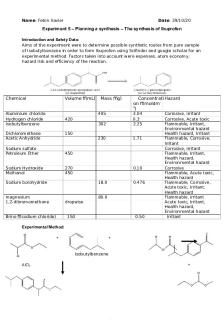Practical 13 Reduction of Benzophenone: Synthesis of Diphenylmethanol PDF

| Title | Practical 13 Reduction of Benzophenone: Synthesis of Diphenylmethanol |
|---|---|
| Course | Chemistry: Molecular Science |
| Institution | National University of Ireland Galway |
| Pages | 2 |
| File Size | 115.6 KB |
| File Type | |
| Total Downloads | 41 |
| Total Views | 140 |
Summary
Practical 13 Reduction of Benzophenone: Synthesis of Diphenylmethanol
First Year
10/10...
Description
Practical 13 − Reduction of Benzophenone: Synthesis of Diphenylmethanol Tabulate your data as follows: Mass of benzophenone (g)
2.2 g
Molar Mass (MM) of benzophenone (g mol-1)
182.21 g/mol
Mass of NaBH4 (g)
0.4 g
Molar Mass (MM) of NaBH4 (g mol-1)
37.83 g/mol
Mass of clock glass (g)
2.11 g
Mass of clock glass with crystals (g)
4.02 g
Mass of crystals (g)
1.91 g
Molar Mass (MM) of diphenylmethanol (g mol-1)
184.238 g/mol
Melting point range (°C)
66-68ºC
Answer the following questions with workings, calculations, and units. 1) How many moles of benzophenone were used? 𝑔𝑟𝑎𝑚𝑠
Moles = 𝑚𝑜𝑙𝑎𝑟 𝑚𝑎𝑠𝑠 2.2 𝑔
Moles = 182.21 𝑔/𝑚𝑜𝑙 = 0.012 moles of benzophenone
2) How many moles of NaBH4 were used? NaBH4 is a source of hydride ions. How many moles of hydride were provided by the amount used? 0.4 𝑔
Moles = 36.83 𝑔/𝑚𝑜𝑙 = 0.01 moles of NaBH4 As there are 4 hydride ions in every molecule of sodium borohydride 0.01 x 4 = 0.04 moles of hydride
3) What is the limiting reagent? Justify your answer. The balanced equation for the reduction of benzophenone by sodium borohydride 4(C₆H₅)₂CO + NaBH4 → 4(C₆H₅)₂CHOH The ratio between the moles of benzophenone and sodium borohydride is 4:1. This means that because there are 0.012 moles of benzophenone present in this reaction, the benzophenone only needs 0.003 moles of sodium borohydride to react with as, 0.012 moles/4 = 0.003 moles. However, there are 0.01 moles of sodium borohydride present in the reaction meaning that it is in excess, and benzophenone is the limited reagent.
1
Also, because there are 0.01 moles of sodium borohydride, it needs 0.04 moles of benzophenone, as 0.01 x 4 =0.04. There are only 0.012 moles of benzophenone present proving that benzophenone is the limiting reagent.
4) What is the theoretical yield of diphenylmethanol in grams? Theoretical yield = 0.012 moles of benzophenone x 184.24 g/mol (Molar mass of diphenylmethanol) = 2.2 grams
5) Calculate the actual percent yield of the reaction. We use the mass of the diphenylmethanol crystals formed and divide it by the theoretical yield of diphenylmethanol that we calculated in the above question and multiple it by 100. 1.91𝑔 100 𝑥 = 86.8% 2.2𝑔 1 5) Explain why the yield is lower than 100%. There are many reasons for this. •
It could be due to loss of sample of diphenylmethanol during recovery, i.e., improper handling of products, losing product during transfer into clock glasses, conical flasks, filtration apparatus
•
Incomplete reaction due to unfavorable reactions conditions, i.e., insufficient time for recrystallization after adding petroleum ether, insufficient energy for substances to react
•
There may have been an excess amount of petroleum ether used to dissolve the mixture, which would have disturbed the recrystallization.
•
Improper use of apparatus, i.e., not cleaning apparatus fully, allowing substances to mix
6) What is the literature melting point of diphenylmethanol? 65-67ºC 7) How does the melting point of your sample compare with the literature data? Explain any discrepancies observed. We recorded a melting point of 68 degrees Celsius, which is a degree higher than the literature melting point of diphenylmethanol. This could be due to using excess sample or poor placement of the sample on the capillary tube or in the melting point apparatus. Heating the diphenylmethanol too fast may also causes discrepancies for the melting point.
2...
Similar Free PDFs

Preparation of Diphenylmethanol
- 4 Pages

Borohydride Reduction of 2
- 8 Pages

Reduction of Camphor- Editor
- 8 Pages

SYNTHESIS OF DIMETHYL ETHER
- 54 Pages

Synthesis of Isopentyl Acetate
- 4 Pages

Synthesis of Sudan-1
- 4 Pages

The synthesis of Ibuprofen
- 4 Pages

Synthesis of methyl orange
- 9 Pages

Synthesis of Aspirin
- 10 Pages

Synthesis of Acetanilide
- 5 Pages

Synthesis of p-nitroacetanilide
- 6 Pages
Popular Institutions
- Tinajero National High School - Annex
- Politeknik Caltex Riau
- Yokohama City University
- SGT University
- University of Al-Qadisiyah
- Divine Word College of Vigan
- Techniek College Rotterdam
- Universidade de Santiago
- Universiti Teknologi MARA Cawangan Johor Kampus Pasir Gudang
- Poltekkes Kemenkes Yogyakarta
- Baguio City National High School
- Colegio san marcos
- preparatoria uno
- Centro de Bachillerato Tecnológico Industrial y de Servicios No. 107
- Dalian Maritime University
- Quang Trung Secondary School
- Colegio Tecnológico en Informática
- Corporación Regional de Educación Superior
- Grupo CEDVA
- Dar Al Uloom University
- Centro de Estudios Preuniversitarios de la Universidad Nacional de Ingeniería
- 上智大学
- Aakash International School, Nuna Majara
- San Felipe Neri Catholic School
- Kang Chiao International School - New Taipei City
- Misamis Occidental National High School
- Institución Educativa Escuela Normal Juan Ladrilleros
- Kolehiyo ng Pantukan
- Batanes State College
- Instituto Continental
- Sekolah Menengah Kejuruan Kesehatan Kaltara (Tarakan)
- Colegio de La Inmaculada Concepcion - Cebu




